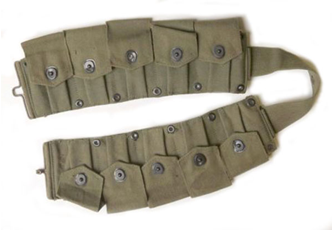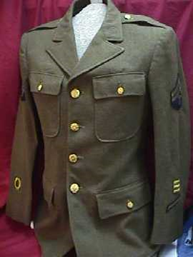Equipment List for the 5th Rangers
- 2LT KRESS

- Feb 19, 2022
- 6 min read
Getting all the right stuff to get started reenacting is a bit intimidating. That's why we put together this buying guide. Part of the hobby is accidentally buying gear that not correct for the impression (or war LOL) but by reading the attached guide, you can get started with less issues. Everybody’s first impulse is to go out and start buying things. Take a deep breath. Here are some fail-safe guidelines:
1. Make sure you know what to buy before you spend money. Read this list carefully and ask questions (to either 2LT Kress or TSGT Shearer) if there is anything you don’t understand.
2. Remember that the 5th Rangers act as a unit, and we dress alike (or, as we say, “Uniform”). There are a lot of things you can buy that are “correct” for somebody at some time, but we look good because we look alike. We do this by choosing as our basic impression the Ranger in June 1944. There are a lot of great items that were issued later (the M1943 field jacket, two-buckle boots, etc.), and you may wish to collect them later. But your priority should be for the items listed below.
3. Don’t buy medic, MP, or other special items. Some units are flags of convenience for individual impressions. We are not. We are all infantry. As time goes on and missions permit, you may sometimes be able to do a specialty impression, but priority is to build infantry private.
4. Prioritize. Most of us can’t afford to go out and buy everything at once, so I’ve listed separately the things you should get right away. Don’t worry if you can’t put together a full kit right away – we have loaners for just about everything to tide you over for the early events.
Sources: There are two kinds of items we collect – original and reproduction. We would all buy only original things, but they are not always available (particularly uniform items, which tend to be in smaller sizes). The best source for originals is eBay, but they are almost always overpriced. EBay is useful as a tool to see examples and cost.
However, there are many sources for good quality reproductions. The most useful are:
a. WWII Impressions at wwiireproductions.com. These items are generally very high quality, but sometimes pricey. I recommend them for most uniform items.
b. What Price Glory (WPG) at whatpriceglory.com. Good quality.
c. At the Front (ATF) at atthefront.com. Slightly narrower selections, good price. Trousers tend to be baggy and may need to be tailored.
The ultimate source for gear is the flea market. Various vendors collect at large events to sell items, mostly original. The best flea market is at the D-day Conneaut Event. The major reproduction outfits (ATF, WWII Impr., etc.) come also.
Initial purchases: There are certain things you should buy first – because of size specifications and because you want to arrive at the first event in reasonable shape.
1. Class B uniform. This is the standard wool uniform worn in all but the hottest weather. It consists of a wool shirt (M37), trousers, belt, type II boots, khaki tie, and overseas cap. Get this first. Any of the three reproduction sources above will do (wwiiimpressions, WPG, ATF). Buy original wool shirts/trousers if you can find them in your size! If not, I’d buy them from At the Front. They’re not perfect, but they’ll be great for your first year.

a. Buy Type II Boots, not field shoes. Type IIs are smooth-out russet leather cap-toe brogans. They can be worn in garrison (as Class B) or in the field; Boots are good only in the field. You will want to get the field shoes later to save the shine on your service shoes.

b. The overseas cap is important. Do not buy the square “envelope” cap sometimes called (incorrectly) an “airborne” cap. The older overseas cap is curved across the top and has a full length crease. The oldest models have no trim; later ones have piping around the edges in the branch color (robin’s egg blue for Infantry).

c. The vendor will ask for your waist size on the belt (to save webbing). Some idiots will send somebody who says “38” a belt exactly 38” long. You want one at least two inches longer than the circumference of your waist. It’s easy to shorten a belt, impossible to make it longer.

d. Tie: This is a cotton khaki item available from most reproducers. There are quite a few original around that can be purchased for about 10$.

2. Field gear. You will want to get geared up for the field, and this requires additions to the basic Class B. You should find: a. Helmet, M1. This is the classic “steel pot”, a stamped steel shell and fiber liner with strapping. Correct helmets have a rough finish. Excruciatingly correct early war helmets have what’s called “fixed bales” and are Front Seam. Vendors will know what this means. Do the best you can. Once you have it, you can paint on the Rangers Diamond using the instructions on the web site.

b. Leggings. These canvas horrors are hard to put on and take off rapidly, but it’s what we wear. Check size carefully (Most People are Size 2R). Don’t spend money on two-buckle late-war boots yet

.
c. Cartridge belt. We all start as riflemen, so we all need the cartridge belt, which has pouches for ammo clips. There is only one size. Important for all web gear: make sure it is khaki, not late-war/Green dark OD.

d. M1928 pack. This is your standard pack. Do not buy a musette bag or a butt pack. Again, one size; it hooks to your cartridge belt. There is a device called a “pack tail” that allows the rolled blanket and tent to be attached, but we seldom carry full field load, so that isn’t a priority. Note: The image below has a meat pouch (Utensils and Pan) attached to the front.

e. Canteen, canteen cup, and pouch. Get the steel kind, not the Viet Nam era plastic canteen. If possible, try to get original. The reproductions look way too shiny.

f. Meat can. This is the two-piece mess kit and knife, fork, and spoon.

g. First aid pouch and Carlisle bandage.

3. Jacket. We wear the M1941 field jacket. This is a priority. Don’t buy an M1943 jacket at first – you will seldom have an opportunity to wear it. ATF makes a Summer 1941 Jacket, Its super nice at the scorching events (i.e. D-Day or Attica)

4. Rifle. Our standard weapon is the M1. Some specialty impressions carry other weapons, but we all start as riflemen. An M1 will set you back some cash – expect to fork over around $1000 unless you have a discount source like CMP. We always have loaners for new members, so don’t despair.

5. Underwear. Yes, this is important. Soldiers were issued old-fashioned tank top undershirts – white or OD (olive drab) are acceptable. White ones are available in clothing stores (cheap at Wal-Mart or Target), though they tend to be ribbed A-shirts. Some reproduction OD shirts are available – check the sources above to see if they have them available. Best bet for shorts is white boxers.

Summary. First priority purchases:
1 (recommend 2) Shirt, wool, OD, enlisted pattern (officer shirts have epilates) M-1937
1 pr (recommend 2) Trousers, OD wool serge, M-1937 or M1942
1 Belt, trouser, khaki web w/ open frame buckle
1 Necktie, khaki
1 pr. Service Boots with M 1936 Leggings
1 Cap, overseas, OD wool with Infantry piping
1 Jacket, field, M-1941 pattern
6 pr. Socks, OD cotton or wool
2-3 Undershirts, tank top, cotton OD or white
I recommend buying two shirts and two pairs of trousers before your first D-day event. D-day Conneaut is a three-day event with two days at the beach, and if you have only one set of wools, they will look like hell by the time of the dinner on Saturday night. (I have four sets, but I’ve always been picky about looking crisp and clean.)
1 canteen, cup, and cover, 1910 pattern
1 cartridge belt, dismounted pattern 10 pocket
1 first aid pouch, field dressing
1 haversack (pack) with meat can pouch, M1928 pattern
1 helmet, M1, w/ liner (webbing should be khaki, not later OD)
1 US Rifle, cal. .30, M1
Second priority. After you have the basic stuff in hand, look at the following:
“Ranger” Boots. Actually they’re paratrooper jump boots issued to the Rangers a few weeks before D-day to assist in climbing. It’s been a joke since then to call them “Ranger” boots as paratroopers seem to think only they were issued them. A lot of the rangers did not want to ruin their new boots and opted to wear their Type IIs with leggings. It’s acceptable to wear either (for both Field and Dress).

Coat, service, OD wool, with US and Infantry brass disks. This is the Class A coat worn as a dress uniform. It looks great, most people are getting them now, and the price has dropped (~$40)

HBT fatigue uniform. This is an Dark OD cotton herringbone twill (HBT) work uniform consisting of a jacket, trousers, and cap (wide brimmed “Daisy Mae” style). It will save wear on your Class B uniform and is good for a lot of field training. Look for Dark Shade Pattern IIs

Gloves, knit wool; there are also good reproduction glove shells with leather palms and fingers.

D-Day impression items. Our unique specialty is D-Day, and the Rangers had some special equipment:
Gas mask, M5 assault, with rubber case. Don’t worry about finding the actual gas mask, I’ve only ever seen one.

Gas brassard, disposable

Try to get to Basic Training and look at these items.
If you have any particular questions, let me know.
- 2LT Kress & TSGT Shearer





Comments